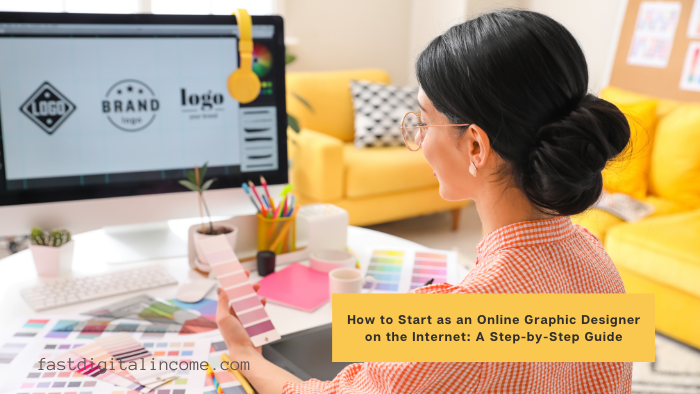Are you a freelancer with a knack for graphic design and a burning desire to tell stories through visuals? Venturing into the world of online graphic design is an exhilarating adventure that presents boundless chances for artistic expression and monetary triumph. This comprehensive handbook will guide you step-by-step in devising and implementing a victorious blueprint to launch your freelance graphic design career on the internet.
Step 1: Hone Your Skills
For freelance graphic designers, it is crucial to establish a solid base of design skills before delving into the realm of online graphic design. Dedicate time to acquire and excel in using industry-standard graphic design software such as Adobe Photoshop, Illustrator, and InDesign. Enhance your understanding by exploring various online tutorials, courses, and books.
Step 2: Define Your Niche
As a freelance graphic designer, it is vital to determine your specific area of expertise within the expansive field of graphic design. Consider which aspect of design work ignites your passion and showcases your skills – whether it be branding, web design, illustration or any other avenue. Concentrating on a particular niche will set you apart from the competition and enable you to attract clients who align with your specialized talents.
Step 3: Create a Portfolio
As a freelance graphic designer, it is crucial to create an impressive portfolio that will set you apart. Begin by crafting a professional website that highlights your top-notch creations. Showcase a diverse range of projects that exemplify your adaptability and mastery in your specific field.
Step 4: Develop a Unique Style
Being a freelance graphic designer, it is essential to cultivate an original design approach that sets you apart from the rest. Engage in experimentation with diverse techniques, color schemes, and typography choices in order to uncover your personal touch. Ensure that your style connects deeply with both your target audience and clients.
Step 5: Acquire the Right Tools
As a freelance graphic designer, it is crucial to make the necessary investment in hardware and software. A robust computer with sufficient RAM and a high-quality monitor is indispensable for your work. Additionally, acquiring licensed software such as Adobe Creative Cloud is essential to excel in design projects.
Step 6: Price Your Services
Develop a pricing strategy for your freelance graphic design services by conducting thorough research on industry standards. Take into account factors such as your level of experience, the specific niche you specialize in, and your geographical location. Begin by setting competitive rates and make necessary adjustments as you acquire more experience and build a solid client base.
Step 7: Build an Online Presence
As a freelance graphic designer, it is crucial to establish a formidable online presence in order to draw in clients. Take advantage of various social media platforms such as Instagram, Behance, and LinkedIn to exhibit your portfolio and establish connections with potential clients. Consistently share your work, actively engage with your followers, and employ appropriate hashtags.
Step 8: Network and Connect
For freelance graphic designers, networking is essential. Engage with online design communities, participate in webinars and conferences, and establish connections with other designers. Cultivating relationships can open doors to collaborations and referrals.
Step 9: Offer Free Resources
Being a freelance graphic designer requires more than just skills – it demands a solid reputation. Establishing yourself as a generous professional can greatly contribute to this goal. Share valuable design resources like templates, fonts, or tutorials on your website or social media channels. This approach not only highlights your expertise but also captivates potential clients who may be drawn to your selflessness and willingness to help others in the industry.
Step 10: Seek Freelance Opportunities
As a freelance graphic designer, you can leverage the power of platforms like Upwork, Fiverr, and Freelancer to connect with potential clients and discover exciting projects. By crafting an engaging profile, establishing transparent pricing, and actively bidding on projects that resonate with your expertise and passions, you can unlock a world of opportunities in the freelancing realm.
Step 11: Deliver Exceptional Work
As a freelance graphic designer, it is crucial to focus on providing top-notch work within the agreed-upon timeframe once you have acquired clients. Building a solid reputation requires effective communication, meticulousness, and a dedication to meeting client expectations.
Step 12: Request Feedback
As a freelance graphic designer, it is important to seek feedback and testimonials from clients after completing projects. Positive reviews and testimonials have the potential to boost your credibility and ultimately attract a larger client base.
Step 13: Scale Your Business
As you advance in your freelance graphic design career, it's worth exploring opportunities to grow your business. This could involve diversifying your services or expanding your team by hiring more designers. Offering additional design services, such as branding packages, and exploring passive income streams like selling design assets can also help you scale your business.
In conclusion, careful planning and flawless execution are essential for aspiring graphic designers looking to make their mark on the internet. By honing their skills, defining their niche, creating an impressive portfolio, and implementing effective marketing strategies, designers can pave the way for a successful online career in graphic design. It is important to remember that building a reputable name and clientele may take time; therefore, patience, dedication, and commitment to delivering outstanding design work are crucial elements for long-term success in this field. With determination and persistence, designers can transform their artistic passion into a thriving online business venture.


